
Emancipation Day Parade, Richmond, Va., 1905
Significant straws in the wind point to social changes in Black Richmond. The findings of the Negro Welfare Survey, of which Mrs. Guild was director, the new Negro Welfare Council and the coming in of federal relief are outstanding factors in new racial attitudes in this colored city within a city
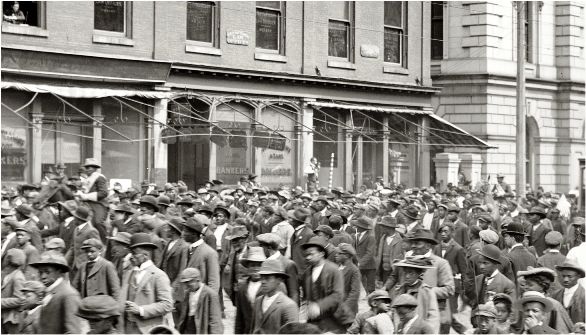
Survey Graphic, Vol. 23, No. 6 (June, 1934), p. 276
THERE were several capitals of the confederacy. But everyone knows that Richmond was, and is, The Capital of the Confederacy. There can never be another Richmond, for she is old, beautiful, historic, glamorous, langorous, cultured, ignorant, prejudiced, generous. We all know people like that, soft-voiced, self-centered, at the same time naive, interesting, exciting. That's Richmond; contradictory and full of contrasts; gorgeous in its gardens in the spring, hideous and unsanitary in its Negro quarters; delightful in sporadic hospitality; disturbing in self-content and indifference to reality; amazing in constant references to the Living Savior of Men and willingness to let His faithful followers suffer neglect; horrifying in Jeffersonian oratory and disregard of the fundamentals of human welfare and justice.

Richmond is a city of 185,000 people. Of these, 53,000 are classified as Negroes. That is to say, located within the confines of the old city, is a separate Negro city of about the size of Austin, Texas; Cedar Rapids or Davenport, Iowa; Decatur, Illinois; Kalamazoo, Michigan; or let the reader mention one. In that crowded, shambly Black Richmond all kinds of Negroes are to be found, for even as you and I, they differ according to heredity and opportunity. There are dandies who drive handsome cars and beautiful girls of the modern mode with painted lips and glossy nails; there are religious exhorters who lash themselves in frenzy on street corners in the name of a white man's God; important Baptist deacons in decent, shabby black; ragged old cronies who always look hungry; racing, screaming children who sometimes really dance—even as in the books; plenty of plain hard-working folk who go out early in the morning and return again slowly at night; scuffling, half-grown boys who have few cares.

The infant mortality rate in Black Richmond is 88 per 1000 births but many still live there who were born in slavery; individual Negroes often show a remarkable ability to survive life's handicaps. The illiteracy rate is approximately 10 percent in Black Richmond but there are many teachers and university professors with ample degrees from Columbia and Harvard, and lawyers, doctors, businessmen, social workers, most of them Richmond-born. That's the one thrilling thing about Black Richmond, the number brought up there who have somehow achieved education, poise, success. A Negro woman born and reared in the black city is the executive director of a large fraternal benefit association, founder and, until recently, the president of a Richmond bank which survived the moratorium. Another small black lady, founder and principal of the one institution resembling a high or vocational school in the neighboring county, has been honored for her achievements by a Harmon Award. Richmond Negroes carry on in many fields away from home, too. Charles Sydney Gilpin who played Emperor Jones, "Bojangles" Robinson of the light and shuffling feet were born in Richmond. Social workers know intimately the National Urban League and its secretary and director of industrial relations, both Richmond men. Legislators in two northern states, a leading doctor and an attorney in Detroit, a state parole officer in New York, a physician on the staff of Bellevue Hospital were born in Richmond.

Why do many able, well-educated Negroes remain in Black Richmond? For most of them, along with the mass of Negro domestics, laborers and unemployed live as completely isolated in Black Richmond from the culture of White Richmond, as though residential segregation were in fact legal and constitutional. The city of Black Richmond itself supplies almost no opportunity for the comforts or the decencies of modern living.
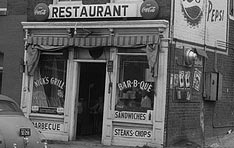
Perhaps the answer is, the Richmond Negro is a Virginian after all. Many Richmond Negroes look as white as their neighbors living just beyond the invisible barrier which separates the black city from the white. Indeed in some of these Negroes flows famous FFV blood, for many of them trace their ancestry back to colonial days. Under Virginia law "any discernible trace of Negro Blood" makes a Negro. Accordingly, it is practically impossible to be in sizeable Negro groups and find any who are free of white taint. Race amalgamation, it would seem therefore, in spite of traditional outcries against it, is inevitable when it is recalled that the very first reference to a Negro in Virginia law is recorded in an enactment at Jamestown designed to punish a white man who had succumbed to the charm of a black woman in 1629. To this day the old commonwealth is one of three states refusing to pass support legislation for illegitimate children. Every time the state assembly meets the same whisper goes round: The state cannot face the embarrassment of bastardy proceedings between plaintiffs and defendants of mixed races. Though law and lip-service may combine to keep Richmond Negroes and whites separate, inexorably they tend to approach one another biologically as well as educationally, culturally, economically.
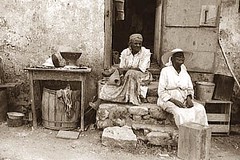
IT should be added that white Richmond does not know, at least it does not often admit, that there can be a common destiny between white and Negro Americans. Few white Richmonders know how black Richmonders live, how they feel, aspire, sicken, die, except as they know Negroes in their white kitchens or as they sentimentally remember the no-longer-existing mammy of a bygone day. The Negroes themselves are generally suspicious of the whites and, as occasion makes politic, deliberately mislead them or play up to the role expected. Nevertheless every year brings new evidence of rapprochement.
There is much more of pertinent interest in this racial scene. Possibly enough has been suggested to serve as background for our major premise: dreary, conflicting, unpropitious as conditions are in Black Richmond, improvements have recently come and dawn may at last be breaking. Let us examine some details in substantiation.
During 1928 and 1929 a Negro welfare survey was conducted in Richmond by a bi-racial committee, employing a Negro and white staff, under the auspices of the Council of Social Agencies. In itself this was an accomplishment in racial progress, if it be remembered that we are talking about the Capital of the Confederacy. The survey was not the result of sudden realization on the part of the community that almost a third of its population was miserably handicapped in every department of life and holding back the other two thirds. The survey simply represented the vision of a few social workers who needed a practical answer to a perplexing question: What are the priorities in the social problems pressing for attention in Black Richmond?
In a general way the promoters of the survey knew the facts and many of the answers before the work was undertaken. But the final printed report of 136 pages dramatized the situation for the first time and set down in easily available form, for blacks and whites alike, outstanding Negro problems and the type of social program needed. A major conclusion of the study recommended the organization of a permanent inter-racial committee to carry on the unfinished work of the survey and to work out its recommendations, where possible.
The Negro welfare survey and its resultant Negro Welfare Council, assisted by the Richmond Community Fund and the depression, have revolutionized the status of the Richmond Negro. A partial list of recent changes summarizes the contention that in the main that status is improving.
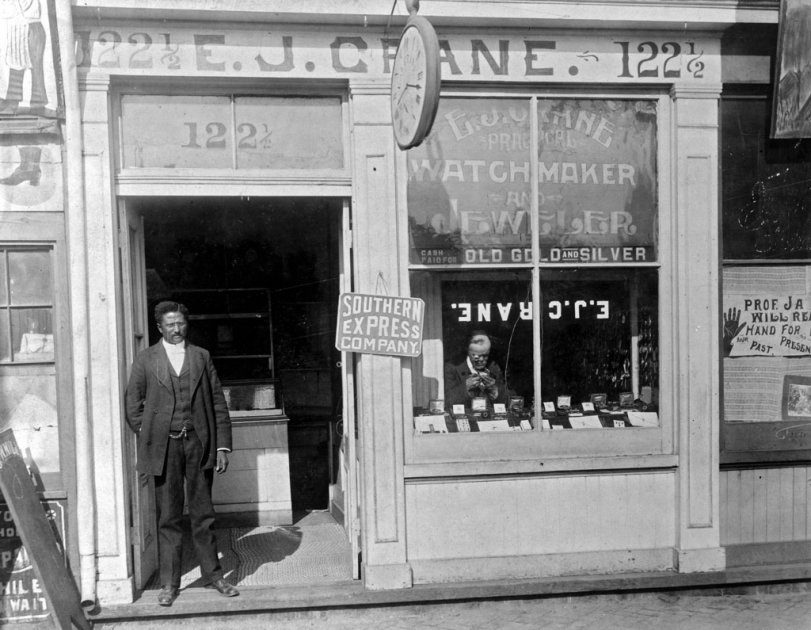
At the time of the survey, Richmond Negroes lived on the average fifteen years less than the whites of the city. The difference in favor of the whites, according to the last report the local health department, notwithstanding the depression, is now fourteen years. This gain, small as it is, is a gain and has come in spite of a very poor record in Negro mortality from tuberculosis, in the same period. During these five years there was an increase in the Negro rate from 147.2 to 174.2 per 100,000 of population, compared to a drop in the white rate from 49.2 to 38.5. In the meantime, additional modern facilities for over seventy-five white tuberculous patients have been provided by the city. Propaganda to remove the small Negro sanitarium from its almshouse location opposite a cemetery, though fruitless to date, has been in itself something distinctly new and if continued may bring results. There is now a Negro nurse on the staff of the tuberculosis association, another novelty. Since the survey, the Medical College of Virginia, a state supported institution, has conducted several summer institutes for Negro physicians.

The Negro welfare survey showed that one third of Richmond Negroes have no water in their kitchens, 70 percent no bath or inside toilet, 65 percent no electricity, 75 percent no gas; 38 percent keep lodgers in homes averaging four rooms each; and unpaved and dirty streets, in Negro sections, are the common rule. Little definite improvement can be shown here, but many in the city do seem to be thoroughly aroused at last to the facts. The comment is made now on all sides that such conditions are a health hazard to Negroes and to the whites as well in whose homes many thousands of Negroes work. Housing committees have been organized, a housing survey with wide publicity has been made by a daily newspaper, and recently a housing corporation attempting to secure federal funds for a Negro housing project has been active. Federal money is putting gutters and sewers in a large section of Black Richmond, and the city itself is condemning and destroying many Negro shanties as unfit for human habitation.

IN the field of education, encouraging indications and some real accomplishments may be seen. The curriculum in the Negro high school has been progressively revised. Negroes are at last permitted to be principals in Negro schools, several have already been appointed. White Richmonders are now saying to one another that of course it is right to have Negro school principals and that they only wish they could have some Negro probation officers in the juvenile court. Richmond has always restricted its visiting-teacher service to white schools but last year permitted a Negro social worker to act as visiting-teacher with excellent demonstrative results. The budget committee of the community fund recommended that paid service be provided. Last year, for the first time, safety patrols were organized in the Negro schools similar to those in white schools. Following the suggestion of the survey, Virginia Union University several years ago established social-work training-classes for Negroes. The city has opened a fine branch library for Negroes. Negro parent-teacher groups are beginning to function actively. Kindergartens, limited in the past almost exclusively to white children, are now, through federal funds, serving many Negro children. There is still no day nursery for the thousands of children whose mothers work, although the survey and the Negro Welfare Council through a special case study of children of employed mothers have called attention to the need. But ladies of white Richmond are beginning to say a nursery for the children of their servants is needed.
Since the survey, the Urban League has been completely reorganized and is becoming a real force in the community. The small, lone and utterly inadequate Negro orphanage has become a modern child-placing agency with an elastic program. Though its budget is small, it is a satisfaction to add that it has recently received an increase.

THE Negro Boy Scouts have become well established, an excellent beginning has been made in Girl Scouting, a Negro summer camp has been operating, a Negro community house was opened last October with a large new gymnasium, erected by public subscription in the year of the depression 1932. The community house gym is the first in the city for Negroes, there being none at the university nor at the Negro YMCA or YWCA as both of these agencies operate in old private houses. In 1932, the last year for which figures are now available, 863 white delinquent children and 859 Negroes, appeared in the juvenile court. In 1927 when the survey looked at Negro delinquency in Richmond the numbers were: white boys and girls 1040, Negroes 826. There are many reasons and conditions to explain why 53,000 Negroes furnish almost the identical number of juvenile delinquents as 132,000 whites but the comment of the juvenile-court judge is not without significance: "It is difficult to explain these figures on any ground other than stress of poverty which has borne down with unusual force upon Negro families, causing the Negro boys to indulge in stealing to satisfy their wants or to relieve actual necessity." In this connection it may be of interest to note that not a penny of the city mothers' pension fund is paid to a Negro mother. The Department of Public Welfare, which dispenses city relief, does not employ a single Negro worker. The municipality in fact refuses to employ Negroes as firemen, policemen, street cleaners or garbage collectors.
Some may say that only an optimist could believe that dawn is breaking in Black Richmond. The answer is that progress in race relations since the Civil War has been almost invisible for decades at a time; if the next five years bring as many discernible changes in Richmond as the last five, the effect will be socially revolutionary, in a long view.

Tolerance is increasing and tolerance is outstandingly needed. White people sometimes now address Negroes as Mr., Mrs., or Miss. Even the newspapers occasionally speak of Negroes so. They have used photographs of Negroes of late. They capitalize the word Negro, too. To those unfamiliar with the southerner's racial attitudes these instances of racial good-will may seem trifling. To a southerner they are of solemn consequence. I have heard white men, "Christian gentlemen," say they would die before they would address a Negro as Mr.; others I have heard say they never in their lives expected to do such a thing and then they have turned around and done it because "after all what difference does it make?" or "it makes for better community feeling." Here little straws may prove the direction of a strong wind. Formerly the Negro division in the community-fund campaign reported at a separate headquarters, now all community-fund workers eat and report at the same meeting, in the same hall, as a matter of course. It is no exaggeration to say that the Negro workers always receive the biggest and most emotional of the ovations. Many an eye is wet when the Negro division reports, many a proud southern heart visibly touched when the meager results of the herculean efforts of that division are announced. I have heard a Negro say that one of them had attended a special church service and had not been asked to leave or go to the gallery. Not much? But unusual, and perhaps it should be added that it is illegal in Virginia not to seat Negroes in public gatherings separately from the whites.
Following the Judge Lowell decision in Boston last summer it was announced that beginning in 1934 Negroes would be included in Richmond jury panels. The law had permitted this before, of course. After a struggle, several qualified Negro social workers have been recommended for membership in the American Association of Social Workers. All this is little enough but Black Richmond knows such things did not happen in other days.
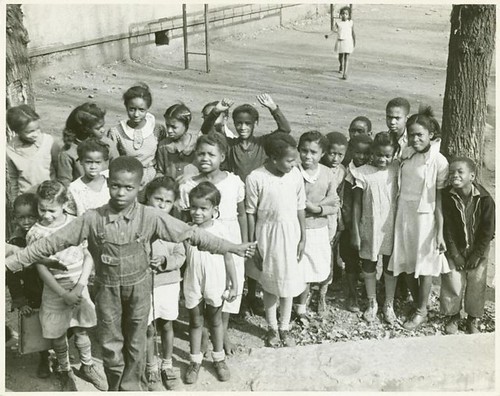
During the early days of the depression, there was flagrant discrimination in the dispensing of relief to Negroes by both public and private agencies. On two occasions the Negro Welfare Council interviewed several hundred unemployed and needy Negroes, checked their cases, formulated recommendations, and saw persons in authority. Improvements have resulted especially in the private agency field. NRA codes have caused the displacement of some Negroes by whites. Undoubtedly new channels of opportunity have been opened to others through the various federal-relief projects. A Negro has been made a member of the state relief committee. It was the common belief not so long ago that hungry Negroes really needed much less food than whites to survive. Now in the most unexpected places whites remark that Negro TB and mortality rates are certainly reflected in that old belief.

Rare Broadside from the Committee [African Americans who organized the celebration] published April 2, 1866. Image from the Virginia Historical Society
LEARNING that relief and work may come directly from the government has caused many Negroes to see the relationship of government, or concretely, voting, to persona1 status. In fact, strangely enough, it is through relief that psychologically the greatest advance has been made in the status of the Richmond Negro. Hungry Negroes have listened eagerly to the city's three or four Communists, organized in a so-called unemployed council. The mayor of the city, unreasonably fearing and hating the Communists, has treated their childish efforts in behalf of adequate relief with ruthless disregard of civil rights. Through the amusing and lawless antics of the mayor the Communists have gained some much desired publicity, and the Negroes as never before, have been aroused to the necessity of paying poll taxes, registering and voting. It is probably not too much to say that the defenseless state of Richmond Negroes in the past has been due largely to their voteless state. They have been voteless because of white aggression and Negro apathy. Future aggression will be met because apathy is fast disappearing in Black Richmond.
The Negro-white problem is infinitely complex; there can be no quick, easy solution. Although Richmond Negroes are better off today strategically than before, their material gains admittedly are small. But the phrase, "We must do more for our Negroes," is heard constantly, nowadays. If Richmond Negroes are indeed to remain "the best in the country" greater accomplishments must prove the good intention. (source: http://newdeal.feri.org/survey/34276.htm)

the Bojangles' Guest Satisfaction Survey. We value your candid feedback and appreciate you taking the time to complete our survey.
ReplyDeleteBojangles Survey